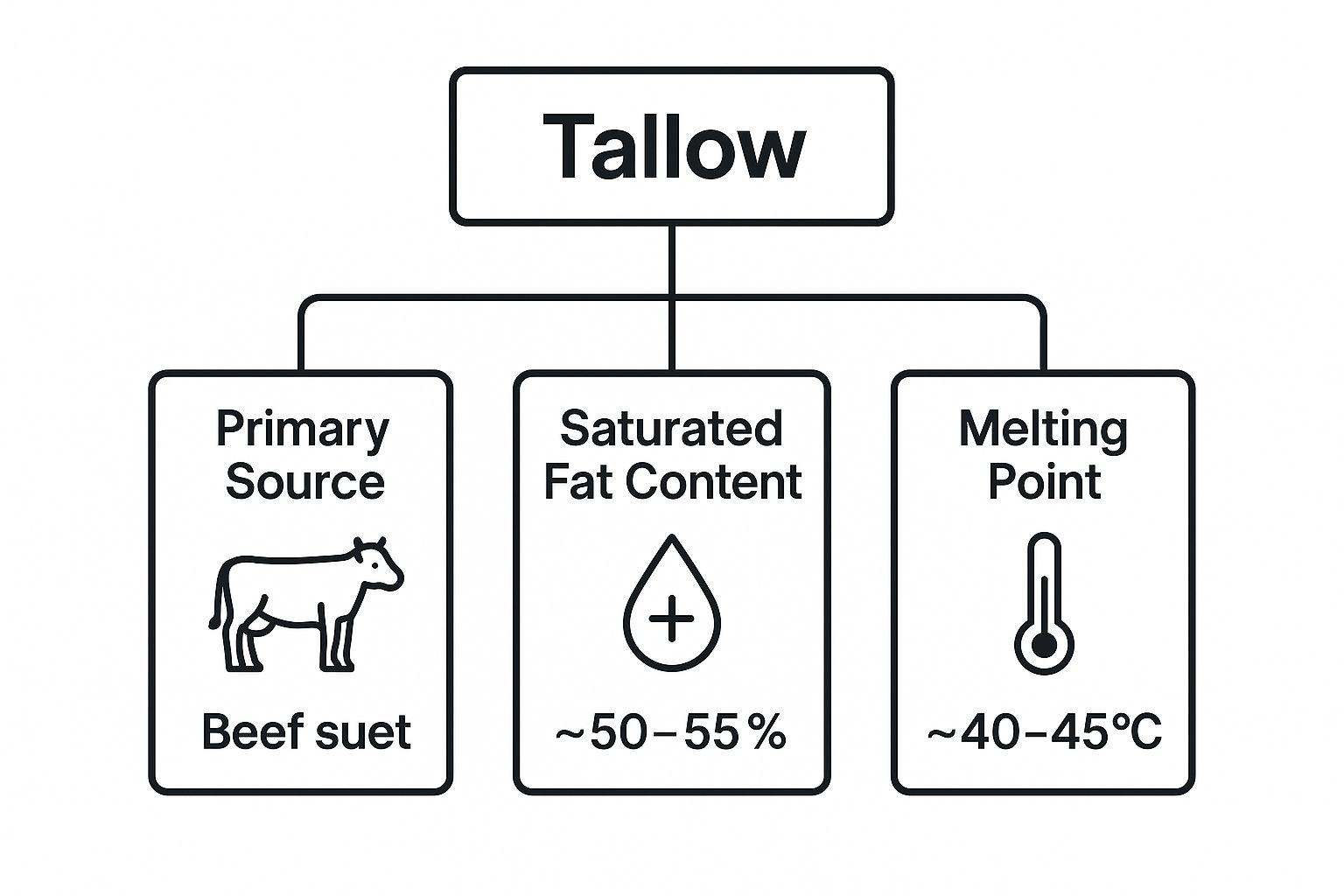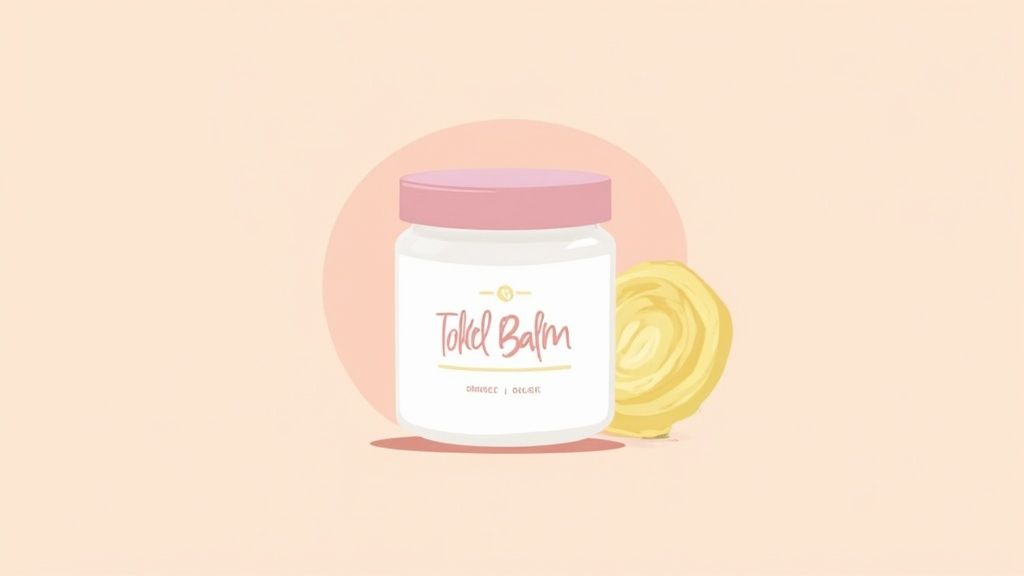Tallow is simply rendered animal fat, most often from beef. For generations, it was a cornerstone of daily life, used in everything from cooking to candlemaking. Now, it's making a serious comeback, thanks to a growing desire for natural, unprocessed ingredients and a "nose-to-tail" approach that values sustainability.
From Humble Staple to Modern Powerhouse
Picture tallow as that forgotten treasure in your great-grandmother's pantry—a workhorse ingredient now being rediscovered for its incredible versatility. For centuries, it was the go-to fat for frying and baking, prized for its stability and rich flavor. Long before electricity, tallow fueled candles that lit homes and its unique properties were perfect for crafting dense, long-lasting bars of soap.
Then came the 20th century and the rise of industrial seed oils. Tallow was pushed aside, often dismissed as old-fashioned and unhealthy. But today, the tide is turning. People are looking for simpler, more natural alternatives to highly processed products, and this shift has put tallow back in the spotlight—not just in kitchens, but in surprising places like high-end skincare boutiques.
The infographic below offers a quick look at tallow's essential properties, from its source to its basic composition.

As you can see, tallow is a solid fat at room temperature with a saturated fat content of around 50-55%, which is what gives it such stability and a unique texture. Its journey from a simple staple to a modern powerhouse is all thanks to its remarkable alignment with our own biology.
Why Is Tallow Gaining Popularity Now?
This isn't just about nostalgia; the renewed interest is firmly rooted in a real understanding of what tallow offers. Modern consumers are drawn to its clean, simple profile. Here’s a breakdown of why it’s making such a strong comeback:
- Nutrient-Rich Profile: Tallow is loaded with fat-soluble vitamins like A, D, E, and K, which are crucial for healthy skin and overall wellness.
- Sustainability: It’s the perfect example of the "nose-to-tail" philosophy. Using tallow means less of an animal goes to waste, turning a byproduct into something incredibly valuable.
- Biocompatibility: The fatty acid profile of tallow is strikingly similar to the oils found in our own skin. This makes it an amazing moisturizer that our bodies readily recognize and absorb. It’s why products like an organic tallow balm are so effective at soothing and protecting the skin.
Tallow isn't just an ingredient; it's a return to ancestral wisdom. Its effectiveness in both the kitchen and skincare lies in its simplicity and natural alignment with our own biology.
Tallow Uses at a Glance
Tallow’s applications are surprisingly broad, spanning from traditional cooking fats to modern skincare formulations. Its unique properties make it a standout ingredient in multiple fields.
The table below provides a quick summary of its primary uses, both old and new.
| Application Area | Primary Use | Key Benefit |
|---|---|---|
| Culinary | High-heat cooking (frying, roasting) | High smoke point and rich, savory flavor. |
| Skincare | Moisturizers, balms, and salves | Deeply hydrates and nourishes skin with biocompatible fatty acids. |
| Soap Making | Creating hard, long-lasting bars | Produces a stable, creamy lather that cleanses without stripping moisture. |
| Candle Making | Traditional fuel source | Burns slowly and cleanly, providing a steady, bright light. |
| Industrial | Lubricants, conditioners | Natural and effective for conditioning leather and lubricating machinery. |
This versatility is exactly why tallow has stood the test of time. It’s a simple, powerful resource that connects us to more traditional, sustainable practices.
Cooking and Frying With Tallow

In the kitchen, tallow isn't just another ingredient—it's a game-changer. Chefs and savvy home cooks are increasingly turning back to this traditional fat, leaving modern seed oils on the shelf. Why? It all comes down to two things: incredible flavor and stellar performance under heat.
Think about searing a steak or frying up a batch of french fries. Many common cooking oils start to break down and smoke when the temperature climbs, filling your kitchen with acrid smells and imparting a burnt taste to your food. Tallow, on the other hand, stands up to the heat, letting you get that perfect golden-brown crispness every single time.
The Science of a Superior Sear
The real secret to tallow's culinary muscle is its smoke point, which sits comfortably around 400°F (205°C). That’s a good deal higher than unrefined oils or butter, making it the perfect partner for high-heat cooking.
When an oil starts smoking, it’s not just a sign that your pan is hot; it's a sign that the oil is chemically decomposing. This breakdown releases unpleasant compounds that can ruin a dish. Because tallow is so stable, you can get your pan ripping hot to create that unbeatable crust on a steak or get impossibly crispy skin on a roast chicken.
Using tallow for frying is like swapping a flimsy pan for a well-seasoned cast-iron skillet. It holds heat beautifully and delivers a consistent, reliable result that takes a dish from good to truly unforgettable.
This kind of reliability is exactly why tallow is making such a huge comeback in both professional kitchens and home cooking. The numbers back it up, too. The global tallow market, valued near $9 billion, is projected to hit $13.6 billion by 2030, with food applications leading the charge. If you want to dive deeper into the data, you can explore the market insights on Grand View Research.
Beyond Frying Perfect Potatoes
Tallow might have earned its fame from creating the world’s crispiest fries, but its talents don't stop there. This versatile fat can add richness and improve texture in all sorts of dishes, often in ways you wouldn't expect.
It’s about more than just deep-frying. Here are just a few ways tallow can elevate your cooking:
- Flaky Pie Crusts: Swap out the shortening or butter in your pastry recipe for tallow. The result is an unbelievably flaky, tender crust with a subtle, savory note you just can't get otherwise.
- Roasting Vegetables: Before they go in the oven, toss your potatoes, Brussels sprouts, or carrots in a little melted tallow. They'll come out with a gorgeous caramelized finish and a deeply satisfying flavor.
- Sautéing and Searing: Whether you're searing scallops or sautéing dark leafy greens, tallow gives you a clean, stable cooking fat that enhances the food's natural flavor without ever feeling greasy.
- Baking Savory Goods: Try adding tallow to your next batch of biscuits or savory scones. It creates a moist, rich crumb with a texture that most modern fats simply can't replicate.
Once you understand how to work with tallow, you open up a whole new world of flavor and texture. It’s a simple switch that can make a huge difference in your everyday meals.
Why Tallow Is Transforming Natural Skincare

While tallow got its start in the kitchen, it's making a huge comeback in a completely different space: natural skincare. It might sound odd at first—slathering rendered animal fat on your face—but the logic behind it is brilliantly simple. Tallow is becoming a celebrated ingredient because its biological makeup is an incredibly close match to our own skin.
This unique compatibility is what really makes it stand out from plant-based oils and synthetic moisturizers. Our skin has a natural protective layer, the lipid barrier, made of oils that lock moisture in and keep irritants out. Tallow's fatty acid profile is so similar to this barrier that our skin essentially recognizes it, absorbs it easily, and puts it right to work.
A Nutrient-Dense Meal for Your Skin
Think of it like feeding your skin the exact nutrients it’s craving. High-quality tallow is loaded with the fat-soluble vitamins our skin needs to repair itself and stay healthy. When you apply it, you’re delivering those powerful nutrients directly where they’re needed most, helping to restore and strengthen your skin from the inside out.
The vitamins found in grass-fed tallow read like an all-star lineup for skin health:
- Vitamin A: Essential for healthy skin cell turnover, keeping your complexion smooth.
- Vitamin D: Plays a huge part in skin cell repair and protecting against damage.
- Vitamin E: A potent antioxidant that fights off environmental stressors and signs of aging.
- Vitamin K: Known for helping to even out skin tone and support the healing process.
This combination works together to create skin that isn't just moisturized on the surface—it's deeply nourished. If you want to dive deeper into how this works, you can explore the many beef tallow benefits for skin in our detailed guide.
Practical Applications for Everyday Skincare
Because it’s so biocompatible, tallow is showing up in all kinds of skincare products meant to tackle common issues without harsh chemicals. It's also generally non-comedogenic, which means it moisturizes deeply without clogging pores, making it a great option for a wide range of skin types.
Tallow acts less like a foreign substance and more like a missing piece of your skin's natural puzzle. It restores balance by giving your skin more of what it's already made of, leading to truly healthy function.
This back-to-basics approach is why so many are turning to tallow. From soothing balms for sensitive skin and eczema to rich, nourishing anti-aging creams, its uses are both practical and effective. People are creating simple, everyday moisturizers that leave their skin feeling balanced, hydrated, and resilient—a real alternative to complicated, synthetic formulas. This return to a traditional ingredient offers a straightforward path to healthy, happy skin.
Making Soaps and Candles the Traditional Way

Long before you could just flip a switch for light or grab a bottle of soap at the store, tallow was the household workhorse. For centuries, it was the raw material for two absolute essentials: light and cleanliness. Looking at how tallow was used for these crafts isn't just a history lesson; it's a peek into a time when people were incredibly resourceful.
What made tallow so perfect for these jobs? It all comes down to its unique chemistry. Being packed with saturated fats gave it the exact properties needed for a good candle and a great bar of soap—qualities that modern, synthetic ingredients still try to imitate.
Fueling the Flame with Tallow Candles
Before paraffin wax, and certainly before electricity, tallow candles were what pushed back the darkness. The best way to think of tallow here is as a solid, slow-burning fuel.
Because of its high melting point, tallow candles were firm and sturdy. They didn’t melt into a puddle on a warm day or drip all over the place like candles made from softer fats. This solid structure meant they burned slowly and steadily, casting a bright, reliable light for hours. Since it was a natural byproduct of farming and butchery, tallow was cheap and accessible for just about everyone.
The Art of Traditional Tallow Soap Making
Tallow truly shines in soap making. The entire process hinges on a chemical reaction called saponification, where you mix a fat (like tallow) with an alkali (like lye) to create soap. Tallow’s specific profile of fatty acids makes it a soap maker’s dream.
It produces a finished bar with some seriously impressive qualities:
- An Incredibly Hard Bar: Tallow creates a rock-hard bar of soap that lasts. It won't dissolve into a slimy mess in your soap dish after a few uses, making it far more durable than many commercial or soft oil soaps.
- Rich, Creamy Lather: Forget those big, flashy bubbles that vanish in a second. Tallow soap produces a dense, stable, and creamy lather that feels fantastic on the skin and cleans thoroughly.
- A Gentle Cleanse: A properly made tallow soap cleans your skin without stripping it of its natural, protective oils. You're left feeling clean but not tight and dry—just moisturized and comfortable.
In soap making, tallow provides the structural backbone for a perfect bar. It offers the ideal balance of cleansing power and moisturizing properties, creating a product that is both functional and gentle on the skin.
This perfect balance is why so many artisan soap makers and people with sensitive skin swear by it. It’s a classic example of how traditional, simple ingredients often give us the best results.
Unexpected Industrial and Modern Applications
Tallow's story doesn't end in the kitchen or on the skincare shelf. Some of its most important roles are hidden in plain sight, powering industries in ways most of us never see. This age-old fat is a major player in the world of oleochemicals—chemicals derived from natural fats and oils.
When tallow is processed, it can be broken down into its fundamental building blocks, like fatty acids and glycerin. Think of it like deconstructing a simple, natural ingredient to get specialized parts. These parts then become the raw materials for countless products we rely on every day.
From Byproduct to Industrial Powerhouse
Tallow's journey into industry is a masterclass in the circular economy. It's a byproduct of the meat industry that gets a second life as a valuable material, which cuts down on waste and creates a more sustainable resource.
You'd be surprised where it shows up:
- Plastics and Polymers: Fatty acids from tallow are often added to plastics to improve flexibility and make them easier to shape during manufacturing.
- Tires and Rubber: It acts as a natural softening agent in the rubber industry, helping improve the durability and performance of tires.
- Lubricants and Greases: Tallow's natural lubricating qualities make it an ideal base for industrial greases that keep heavy machinery running smoothly.
This incredible versatility proves just how far tallow has come from its humble origins. Its ability to be transformed into these core industrial components also explains its massive economic footprint. The global beef tallow market is a serious business, with a valuation around $15 billion and a projection to hit $26.12 billion by 2035. For a deeper dive into market trends, you can check out the analysis from Business Research Insights.
Fueling a Greener Future with Biodiesel
Perhaps tallow's most impactful modern use is in making biodiesel. As the search for cleaner energy sources intensifies, tallow has stepped up as a fantastic feedstock for creating a renewable, low-emission fuel.
Biodiesel produced from tallow is considered a second-generation biofuel. This means it's made from a byproduct or waste stream, so it doesn’t compete with food crops for agricultural land.
The process is straightforward: tallow is converted into a liquid fuel that can run in diesel engines, often without any major modifications. The fuel it produces burns cleaner than standard petroleum diesel, which means fewer harmful emissions.
By turning an animal byproduct into green energy, tallow is playing a direct role in building a more sustainable fuel cycle. In fact, this single application is a huge driver of its market growth, accounting for about 32% of its total demand.
How Tallow Fits into the Global Economy
To really understand tallow's role today, you have to think bigger than just a jar in the kitchen. It’s a global commodity, with its own economic ebb and flow. Since tallow is a direct byproduct of the meat and dairy industries, its entire lifecycle—from supply and availability to price—is directly tethered to larger agricultural trends.
If beef demand goes up, so does the potential supply of tallow. If it drops, the tallow market feels it. This creates a fascinating dance where a simple, traditional fat becomes a key player on the international stage. It's not just a niche ingredient anymore; it’s a crucial raw material that keeps massive industries running all over the world.
Major Producers and Consumers
The global trade in tallow is a huge, bustling market. Unsurprisingly, the world’s biggest beef producers—countries like the United States, Brazil, and Australia—are also the biggest suppliers of tallow. They have the infrastructure to render the enormous amounts of fat from their meat processing plants and ship it across the globe.
Who’s buying it? Just about everyone. Industrialized nations snap it up for producing oleochemicals and biodiesel. In other parts of the world, it remains a go-to, affordable cooking fat. This global trade really highlights how a byproduct from a farm in one country can become a critical industrial ingredient in another.
Tallow acts as a bridge in the global economy. It connects the world's food supply chain to its industrial and energy sectors, ensuring that almost nothing goes to waste.
Take the United States, for instance. It's an absolute powerhouse in the tallow market. Domestic consumption alone recently hit around 4.5 million tons. That's a massive number. With a total market value estimated at $4.7 billion, it’s clear tallow pulls some serious economic weight. You can dig deeper into the numbers with this U.S. tallow market overview on IndexBox. This isn't just a byproduct; it's an economic engine.
Answering Common Questions About Tallow
Even with its incredible history and benefits, it's natural to have questions before diving into the world of tallow. Let's tackle some of the most common ones I hear, so you can feel completely confident bringing it into your kitchen or skincare routine.
The first question is almost always about the taste. People worry their food will taste, well, beefy.
Does Food Cooked with Tallow Taste Like Beef?
This is a great question, and the answer might surprise you. High-quality, properly rendered tallow has a remarkably neutral flavor profile. Instead of hitting you with a heavy "beef" taste, it brings a rich, savory depth that actually makes food taste more like itself.
Think about those unbelievably good restaurant french fries or that perfectly flaky pie crust. That's the magic of tallow at work—it enhances flavor without overpowering it. It all comes down to the rendering process. A clean, careful rendering removes the impurities that can create off-flavors, leaving you with a pure, beautiful cooking fat.
Is Tallow Good for All Skin Types?
Since tallow’s fatty acid profile is so close to the oils our own skin produces, it’s a fantastic match for most people, especially those with dry or sensitive skin. It’s also generally considered non-comedogenic, meaning it's unlikely to clog your pores.
Tallow truly works with your skin, not against it. It reinforces your natural lipid barrier, helping to lock in moisture and protect it from environmental stressors. That's why so many find it incredibly soothing.
Of course, everyone's skin is different. If you have very oily or acne-prone skin, it's always smart to do a little patch test on your arm first. You might also start with products designed specifically for the face, like a gentle tallow face wash, which cleanses without stripping away your skin's natural oils.
Is Using Tallow a Sustainable Choice?
Yes, absolutely. Using tallow is a perfect example of the "nose-to-tail" philosophy in action. It honors the animal by ensuring that every part is put to good use, which dramatically cuts down on waste in the meat industry.
By giving value to a part of the animal that might otherwise be thrown away, tallow helps create a more responsible and circular food system. Its emerging role in creating biofuels also shows how this byproduct can become a renewable resource, making it a fantastic choice for anyone living a more conscious lifestyle.
At Wild Tallow Skincare, we believe in the power of simple, traditional ingredients. Our products are handcrafted with 100% grass-fed tallow to nourish and protect your family's skin. Discover our gentle, effective formulas at https://wildtallow.com.

